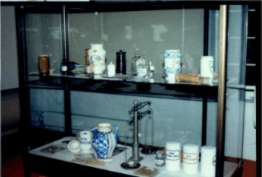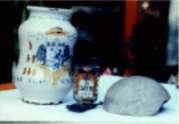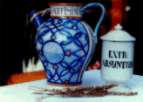Room 4: Therapy
 Attempts at treating Epilepsy in the Ancient World
Attempts at treating Epilepsy in the Ancient World
- Humoral pathology
- Dietetics
 Attempts at treating Epilepsy in the Christian Middle Ages
Attempts at treating Epilepsy in the Christian Middle Ages
- Phytotherapy
- Hagiotherapy
 Attempts at treating Epilepsy during the Renaissance
Attempts at treating Epilepsy during the Renaissance
- Chemical substances
- Epilepsy surgery

The Ancient World
Attempts to treat epileptic seizures and the disease epilepsy date back to prehistoric times.
In every historical epoch, the beliefs which people held about the disease dictated the types of therapy which were used.
In the time before Hippocrates, when the "sacred disease" was thought to be an illness sent by the gods, people would offer sacrifices, seek expiation and take part in religious acts under the instruction of doctor-priest(preferably in the temple) in an attempt to be cured.
The supporters of Hippocratic medicine, who believed that epilepsy had a natural cause, tried to treat the disease using natural means (humoral pathology: the ancient physiological theory of fluids or humors). The treatment was based on dietetics, or a structured, "sensible" lifestyle. This dietetic therapy was based on three pillars: dietary regulations, the regulation of excretions, and physiotherapy. In addition to dietetics, medicines, which were mainly of a herbal nature, played only a secondary role.
The Christian Middle Ages
In the Middle Ages, epilepsy was no longer considered to have natural causes but was rather thought to be the work of devils, evil spirits and demons ("morbus daemonicus"). As a result, "therapeutic" methods also changed and took the form of prayer, fasting, offering sacrifices, making pilgrimages or undergoing "exorcisms"
People turned to several saints for direct help or prayed to them to intercede with God on their behalf. Many sacred, devotional objects were used to combat epilepsy (treatment using the saints and sacred objects: "hagiotherapy").
After the plague, epilepsy was the disease with the most saints who were "responsible" for providing a cure, and the most important one in Germany was Valentin (probably because of the similarity of his name with the German words for "to fall" [fallen], "falling sickness" [Fallsucht], and "don’t fall down" - fall net hin - Valentin).
|
Fraisen-Kette or Froasket'n (the convulsion chain):
|
Alongside the medieval Christian attempts to find a cure, various superstitious methods of treatment also developed, e.g. spells, witchcraft, fetishism, the use of amulets. These actually continue to be used in some countries today. "Phytotherapy" - treatment using plants and parts of plants - was also widely used in the Middle Ages. |
During this period there was hardly a plant which was not used to treat the "falling sickness", as epilepsy was called. The most important plants were: valerian, peony, mugwort, thorn-apple, common henbane, mistletoe, belladonna, foxglove, bitter orange and Peruvian bark.
The Renaissance to the Present
During the Renaissance, chemical substances were increasingly used to treat the "falling sickness". The most important of these were: copper (which had already been used by the Ancient Greeks), zinc oxide, silver nitrate, mercury, bismuth and tin.
 Castor
Castor
As early as ancient Greek and Roman times, a resinous secretion from the scent glands of the beaver (castor sacks) was used as a remedy for the "holy disease": Castoreum. Up until well into the 19th century, this substance was widely used as a sedative and a remedy for convulsions and was to be found in every apothecary.
The human scull (cranum humanum)
This was considered to be an effective remedy for treating the falling sickness throughout many eras: "Scrape a little matter from a human scull and administer this over a period of several months. If the patient is a man, the scull must be that of a woman, and vice versa" (folk remedy from Württemberg).
 Mugwort (artemisia vulgaris)
Mugwort (artemisia vulgaris)
In earlier centuries, this was the magical cure-all. Even in orthodox medicine mugwort was believed to be an effective remedy for epilepsy. Absinth, which has in it the amaroids from mugwort flowers, was also used to treat epilepsy.
Today, there is no doubt that none of these plant or chemical substances had any effect whatsoever on epileptic seizures. It was not until the second half of the 19th century, when people began to learn more about epilepsy and medicine that drugs were finally found which did have an effect on epileptic seizures. The first two substances which were proven to have an anti-epileptic effect and which are still used today, were bromine (first used in 1857) and phenobarbitone (first used in 1912).

Today, there are about 20 chemical substances which can be used successfully to treat epileptic seizures, either singly or in combination therapy.
Just under 60% of all people with epilepsy can become seizure free under modern drug therapy. In another 20% the seizures can be drastically reduced, and only in one fifth of all epileptic patients do modern anti-epileptic drugs fail to have any effect whatsoever. Modern epilepsy surgery can help a number of these "therapy-resistant" patients, however.


